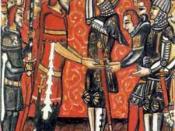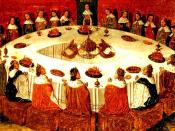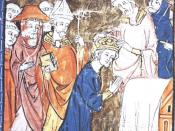Supported by the brawn and taxes of the peasants, the feudal
baron and his wife would seem to have had a comfortable life. In many
ways they did, despite the lack of creature comforts and refinements.
Around the 12th century, fortified manor dwellings began to give
way to stone castles. Some of these, with their great outer walls and
courtyard buildings, covered around 15 acres and were built for
defensive warfare. Even during the hot summer months, dampness clung to
the stone rooms, and the lord and his entourage spent as much time as
possible outdoors. At dawn, a watchman on top of the lookout tower
blasted out a note on his bugle to awaken everyone in the castle. After
a small breakfast of bread and wine or beer, the nobles attended mass in
the chapel at the castle. The lord then went about his business. He
first may have heard the report of an estate manager (a manager of plot
of land).
If a discontented or badly treated serf had fled, without a
doubt, the lord would order special people called retainers to bring him
back. This is because serfs were bound to the lord unless they could
evade him for a year and a day. The lord would also hear the petty
offenses of the peasants and fine the culprits, or, he might even
sentence them to a day in the pillory. Serious deeds, like poaching or
murder, were legal matters for the local court or royal 'circuit' court.
The lady of the castle had many duties of her own. She inspected the
work of her large staff of servants, and saw that her spinners, weavers,
and embroiderers furnished clothes for the castle and rich robes for the
clergy. She and her ladies also helped to train the...


